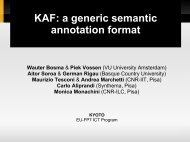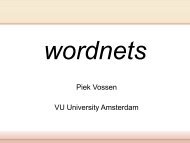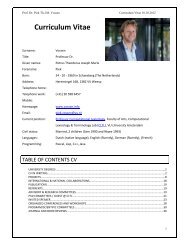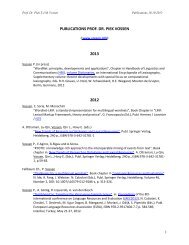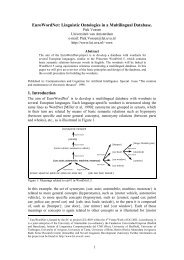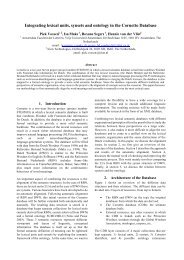From SIFT Lexical Knowledge Base to SIFT ... - Prof. Piek Vossen
From SIFT Lexical Knowledge Base to SIFT ... - Prof. Piek Vossen
From SIFT Lexical Knowledge Base to SIFT ... - Prof. Piek Vossen
Create successful ePaper yourself
Turn your PDF publications into a flip-book with our unique Google optimized e-Paper software.
<strong>From</strong> <strong>SIFT</strong> <strong>Lexical</strong> <strong>Knowledge</strong> <strong>Base</strong> <strong>to</strong> <strong>SIFT</strong> <strong>Lexical</strong> Data <strong>Base</strong>:<br />
Creating a Reposi<strong>to</strong>ry for Lexicological Research and Development<br />
Richard F. E. Sutcliffe*, <strong>Piek</strong> <strong>Vossen</strong>#, Iskandar Serail#,<br />
Peter Masereeuw#, Peter Hellwig&, Paul Boersma#,<br />
Annelies Bon#, Annette McElligott*,<br />
Donie O'Sullivan* and Liam Sheahan*<br />
Department of Computer Science*<br />
and Information Systems<br />
University of Limerick<br />
Limerick, Ireland<br />
sutcliffer@ul.ie<br />
+353 61 333644<br />
+353 61 330876 (Fax)<br />
Computer Centrum Letteren#<br />
University of Amsterdam<br />
Amsterdam, The Netherlands<br />
University of Heidelberg,&<br />
Karlstrasse 2,<br />
D-6900 Heidelberg,<br />
Germany<br />
LINGDB'95 Topic areas:<br />
3. Developing (maximally) theory-neutral db schemas for annotation<br />
systems.<br />
6. Needs of applications such as lexicography.<br />
What is <strong>SIFT</strong>?<br />
-------------<br />
We have developed a paradigm which allows word meanings <strong>to</strong> be captured using<br />
distributed patterns, that is lists of pairs. These<br />
representations are generated au<strong>to</strong>matically from machine readable dictionaries<br />
by a family of taxonomic traversal algorithms. The meaning of two word senses<br />
can be directly compared in this paradigm, yielding a value between zero and<br />
one.<br />
In the LRE-2 <strong>SIFT</strong> project we are developing a system for text retrieval from<br />
Technical Manuals. The system takes as input a query relating <strong>to</strong> the content of<br />
the manuals. This is converted <strong>to</strong> a distributed pattern which is then "swept"<br />
over the patterns corresponding <strong>to</strong> units of the text looking for a good<br />
match. Salient portions of text are then shown <strong>to</strong> the user for perusal. The<br />
<strong>SIFT</strong>-1 pro<strong>to</strong>type is virtually complete. In <strong>SIFT</strong>-2, representations will capture<br />
semantic case information derived from queries and text utterances via PLAIN<br />
parse trees (Hellwig, 1980, 1989).<br />
The <strong>SIFT</strong> LDB
------------<br />
The project has necessitated the development of a database for containing<br />
word-based linguistic information required either for the <strong>SIFT</strong> systems<br />
themselves or for the research work which is entailed by their construction.<br />
The lexical data is mainly obtained from the Prince<strong>to</strong>n WordNet (Beckwith,<br />
Fellbaum, Gross and Miller, 1992) and the Longman Dictionary of Contemporary<br />
English (LDOCE) (Proc<strong>to</strong>r, 1978), the latter in the form of lexical data created<br />
following experience gained in the ACQUILEX project (<strong>Vossen</strong>, 1990a, 1991a,<br />
1991b).<br />
The work has raised the following fundamental issues:<br />
* in the context of text retrieval, what exactly is a lexical database?<br />
* what can and can not be represented in such a reposi<strong>to</strong>ry?<br />
* how can such a database be best engineered <strong>to</strong> allow maximum flexibility in<br />
the use of the information it contains?<br />
The activities which we wish <strong>to</strong> carry out using the LDB are as follows:<br />
* the indexing of documents using word meanings and related data, carried out<br />
as an "offline" process,<br />
* the retrieval process itself, involving construction in real time of a<br />
meaning representation for the input query,<br />
* the development and testing of taxonomic traversal algorithms used in the<br />
construction of the distributed meaning representations,<br />
* the construction and maintenance of terminological data associated with the<br />
application domain (Lotus Ami Pro).<br />
* the organisation and maintenance of lexical information required for building<br />
the syntagmatic parsing lexicon required for PLAIN.<br />
Progress<br />
--------<br />
So far, a lexical database has been built which provides very efficient access<br />
<strong>to</strong> unstructured data (Masereeuw, 1994). It is engineered <strong>to</strong> allow use of the<br />
same database and access software on the Sun, PC and Macin<strong>to</strong>sh computers. We<br />
are currently investigating how best <strong>to</strong> structure the data in order <strong>to</strong> support<br />
the activities outlined above.<br />
Major issues which have arisen so far are:<br />
* for each type of data, whether <strong>to</strong> use native binary formats (which are fast)<br />
or Prolog-based formats (which are flexible and convenient)<br />
* how <strong>to</strong> determine and maintain links between material derived from different<br />
sources (e.g. LDOCE and WordNet) and intended for widely different purposes<br />
(e.g. parsing and lexical semantic representation)<br />
Contribution <strong>to</strong> the Workshop<br />
----------------------------
The <strong>SIFT</strong> project raises many questions relating <strong>to</strong> lexical databases which are<br />
relevant <strong>to</strong> other researchers in computational lexicology, information<br />
retrieval and related areas. We would propose <strong>to</strong> describe our <strong>SIFT</strong> findings and<br />
<strong>to</strong> explain potential applications of the ideas in other domains.<br />
References<br />
----------<br />
Beckwith, R., Fellbaum, C., Gross, D., & Miller, G. A. (1992). WordNet: A<br />
<strong>Lexical</strong> Database Organised on Psycholinguistic Principles. In U. Zernik (Ed.)<br />
Using On-line Resources <strong>to</strong> Build a Lexicon. Hillsdale, NJ: Lawrence<br />
Erlbaum Associates.<br />
Hellwig, P. (1980). PLAIN - A Program System for Dependency Analysis and for<br />
Simulating Natural Language Inference. In L. Bolc (Ed.) Representation and<br />
Processing of Natural Language (271-376). Munich, Germany, Vienna, Austria,<br />
London, UK: Hanser & Macmillan.<br />
Hellwig, P. (1989). Parsing natuerlicher Sprachen: Grundlagen, Realisierungen.<br />
In S. B. Tori, W. Lenders & W. Putschke (Eds.) Computational Linguistics.<br />
An International Handbook on Computer Oriented Language Research and<br />
Applications (Handbooks of Linguistics and Communication Science, Vol. 4) (pp.<br />
348-431). Berlin, Germany: de Gruyter.<br />
Masereeuw, P. C. (1994). LTREE and CM: The <strong>SIFT</strong> LDB Developer's Libraries (<strong>SIFT</strong><br />
deliverable D10). Amsterdam, The Netherlands: University of Amsterdam, Computer<br />
Centrum Letteren.<br />
Proc<strong>to</strong>r, P. (Ed.) (1978). The Longman Dictionary of Contemporary English<br />
(LDOCE). London, UK: Longman.<br />
Sal<strong>to</strong>n, G. (Ed.) (1971). The SMART Retrieval System - Experiments in Au<strong>to</strong>matic<br />
Document Processing. Englewood Cliffs, NJ: Prentice Hall.<br />
Sutcliffe, R. F. E. (1993). Constructing Distributed Semantic <strong>Lexical</strong><br />
Representations using a Machine Readable Dictionary. In K.T. Ryan and<br />
R. F. E. Sutcliffe (eds) Proceedings of AICS-91 - The Fifth Irish Conference on<br />
Artificial Intelligence and Cognitive Science, University of Limerick, 10-11<br />
September 1992. London, UK, Berlin, FRG, Heidelberg, FRG, New York, NY:<br />
Springer-Verlag<br />
Sutcliffe, R. F. E., McElligott, A., O Neill, G. (1993). Using<br />
Distributed Patterns as Language Independent <strong>Lexical</strong> Representations. In<br />
Proceedings of the AAAI-93 Spring Symposium Series: Building Lexicons for<br />
Machine Translation, March 23-25, 1993, Stanford, University, CA.<br />
Sutcliffe, R. F. E., O'Sullivan, D., Meharg, F. (1994). A Lexicon of<br />
Distributed Noun Representations Constructed by Taxonomic Traversal.<br />
Proceedings of the 15th International Conference on Computational Linguistics,<br />
(COLING'94), Kyo<strong>to</strong>, Japan.<br />
Sutcliffe, R. F. E., O'Sullivan, D., Sharkey, N. E., <strong>Vossen</strong>, P., Sla<strong>to</strong>r, B. E.<br />
A., McElligott, A., & Bennis, L. (1994). Psychometric Performance Metrics for<br />
Semantic Lexicons. Proceedings of the International Workshop On Directions of<br />
<strong>Lexical</strong> Research, 15-17th of August, 1994, Beijing, China.<br />
<strong>Vossen</strong> P. (1990a). A Parser-grammar for the Meaning Descriptions of the<br />
Longman Dictionary of Contemporary English. (Tech. Rep. NWO, project no.<br />
300-169-007). Amsterdam, Netherlands: University of Amsterdam.
<strong>Vossen</strong>, P. (1990b). The end of the chain: where does stepwise lexical<br />
decomposition lead us eventually? In Proceedings of the 4th Functional<br />
Grammar Conference, June 1990, Kopenhagen, Denmark. Also available as Acquilex<br />
Working Paper No. 010, July 1990 , Esprit BRA-3030, University of Amsterdam.<br />
<strong>Vossen</strong>, P. (1991a). Converting data from a lexical database <strong>to</strong> a knowledge<br />
base. Acquilex Working Paper no 027, Esprit BRA-3030, November 1991,<br />
Amsterdam.<br />
<strong>Vossen</strong>, P. (1991b). An empirical approach <strong>to</strong> au<strong>to</strong>matically construct a<br />
knowledge base from dictionaries. Paper <strong>to</strong> be presented at The Euralex<br />
conference, Tampere, 1992 Also available as Acquilex Working Paper no. 25,<br />
Esprit BRA-3030, Amsterdam.<br />
<strong>Vossen</strong>, P. (1991c). Polysemy and vagueness of meaning descriptions in the<br />
Longman dictionary of contemporary English. In S. Johansson & A. Stenstrom<br />
(Eds.) English Computer Corpora. Selected Papers and Research Guide.<br />
Berlin, Germany: Mou<strong>to</strong>n de Gruyter. Also available as Acquilex Working Papers<br />
no. 1, Esprit BRA-3030, Amsterdam, 1989.<br />
<strong>Vossen</strong>, P., Meijs, W., & Broeder, M. den (1989). Meaning and structure in<br />
dictionary definitions, In B. Boguraev and E. G. Briscoe (Eds.)<br />
Computational Lexicography for Natural Language Processing. London, UK:<br />
Longman.<br />
<strong>Vossen</strong> P., & Copestake, A. (Forthcoming, 1992). Untangling Definition<br />
Structure in<strong>to</strong> <strong>Knowledge</strong> Representation. To appear in E. G. Briscoe, A.<br />
Copestake and V. de Paiva (Eds.) Default Inheritance in Unification <strong>Base</strong>d<br />
Approaches <strong>to</strong> the Lexicon. Cambridge, UK: Cambridge University Press. Also in<br />
Proceedings of the ACQUILEX workshop on Default Inheritance in the<br />
Lexicon, April 1991, Cambridge.<br />
<strong>Vossen</strong>, P., & Serail, I. (1990). Devil: a taxonomy browser for<br />
decomposition via the lexicon. Esprit BRA-3030 Acquilex WP No. 009, University<br />
of Amsterdam, Amsterdam.





